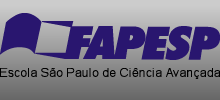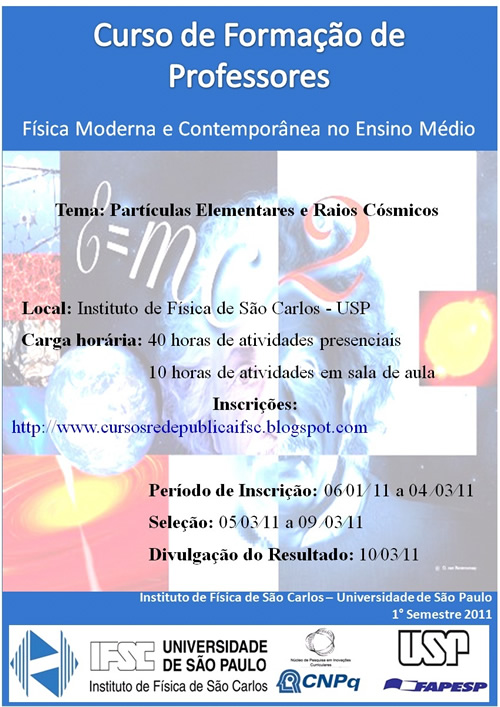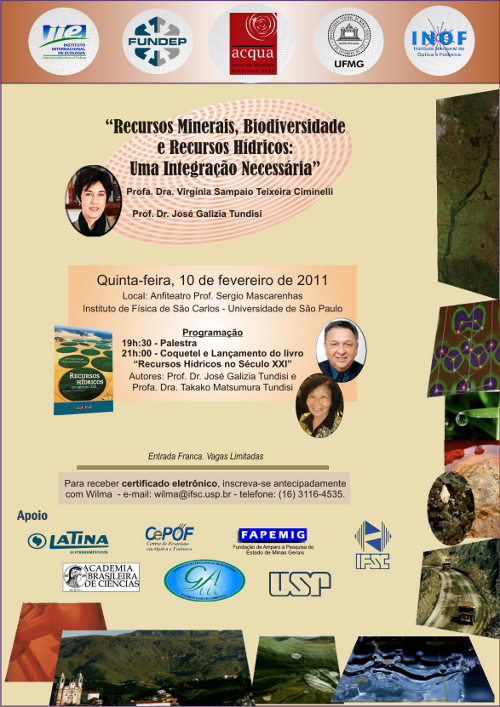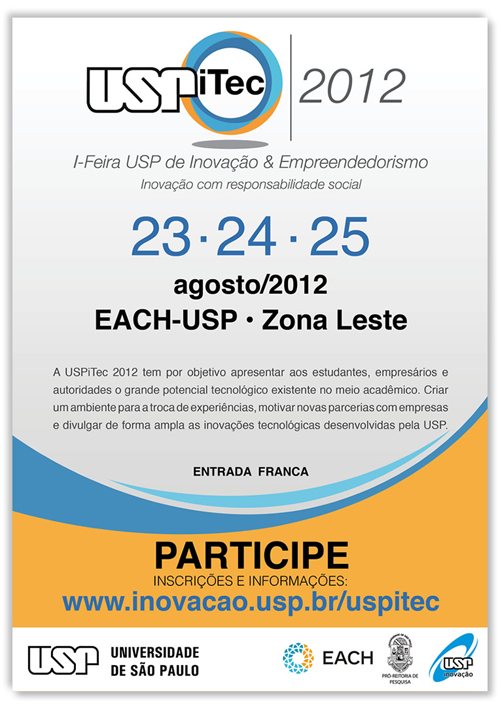Escola São Paulo de Ciência Avançada

http://www.ifsc.usp.br/~espca/
Data: 4 a 14 de abril

Data: 19 de março a 14 de maio
O XX Simpósio Latino Americano de Física do Estado Sólido realizar-se-á em Maragogi, Alagoas, 27 — 31 de março, 2011 .
O site do evento já está no ar: http://www.slafes-xx.ifsc.usp.br/
Esta edição do SLAFES vai continuar a tradição das anteriores, com seu escopo bastante amplo, tendo como públicos-alvo físicos, químicos, cientistas de materiais etc.
A lista preliminar de palestrantes (todos confirmados — com exceção de dois nomes com **) é:
A lista acima enfatiza a diversidade de temas a serem tratados no evento.
O programa completo do SLAFES XX estará disponível em futuro próximo no site. Além de plenárias, tutoriais, palestras convidadas e contribuições orais curtas haverá também sessões de pôsteres e mais uma edição do workshop intitulado “Meet the Editors” durante o evento.
A submissão de abstracts e a subsequente submissão de trabalhos completos (a serem publicados no Journal of Superconductivity — veja instruções na página do evento) logo estarão disponibilizadas via site.
Assessoria de Comunicação
Data: 27 a 31 de Março
Será organizado o segundo “Encontro sobre Energia Nuclear e Proteção Ambiental”, durante o período de 23/03/2011 a 25/03/2011 em São Carlos no Instituto de Física de São Carlos da Universidade de São Paulo. O evento se dará no escopo do Acordo IFUSP/USP – Eletronuclear especificamente previsto em convênio destinado ao estudo do armazenamento de combustível nuclear usado.
O objetivo precípuo do encontro esta relacionado com a formação de recursos humanos preparados para os desafios que se apresentam, de um lado com o inevitável desenvolvimento da indústria nuclear e de outro com a proteção ambiental que viabilize esse processo.
Em São Carlos temos um amplo sistema universitário composto pelo Campus de São Carlos da Universidade de São Paulo, a Universidade Federal de São Carlos e outras instituições privadas de ensino universitário. Existem também duas unidades da Embrapa e parques tecnológicos aglutinando empresas de tecnologia de vanguarda.
A iniciativa tem como alvo a comunidade universitária e empresarial (mas pretende também contribuir para a população em geral), fornecendo uma visão cientificamente correta das vantagens do uso de processos nucleares para a geração de energia elétrica.
O tema do primeiro encontro foi centrado em repositórios geológicos definitivos enquanto que o presente pretende focalizar o armazenamento de médio prazo, reaproveitamento do combustível e segurança ambiental de instalações nucleares em geral.
A participação da comunidade tecno-cientifica é fundamental, não somente na forma de apresentações, palestras e debates, mas também propondo temas correlatos e áreas de interesse. Esse convite se estende ao setor industrial principalmente no tocante as possibilidades profissionais para os estudantes das engenharias, física, química e matemática.
Esperamos contar com a participação de todos no Encontro bem como na sugestão de temas.
Data: 23 a 25 de março

Data: 10 de fevereiro
Horário: 19h30
Science Research at the University of East Anglia and Potential Areas for Collaboration: with Duncan Craig, Tharin Blumenschein and Susan Barker
The University of East Anglia is a world top 150 university (Times Higher Rankings) with particular strengths in the applied sciences. It is located approximately 150km to the north east of London and is set in the historic and beautiful city of Norwich, very close the famous Norfolk Broads (several hundred km of artificial waterways).
We are key partners of the Norwich Research Park, comprising the John Innes Centre (world leading plant science institution), the Institute of Food Research, the Genome Analysis Centre, the Sainsbury Laboratory and the Norfolk and Norwich Hospital.
UEA is a uniquely collaborative institution, with all our science schools working in conjunction and each school comprising scientists with a range of backgrounds.
These schools include Chemistry, Pharmacy, Environmental Sciences, Mathematics, Computing Sciences and Biological Sciences, with aspects of Physics, Engineering and Social Sciences being included in the activities of some or all of the schools. We are looking to extend and deepen our overseas relationships and hence we are very interested in exploring collaborative possibilities with the University of Sao Paulo.
In order to facilitate this, the lecture will consist of four stages:
a) An introduction to UEA and the Science Faculty (Prof Duncan Craig, Director of Internationalisation);
Here we will give an overview of the university plus a very brief description of each of the Schools in the Faculty of Science. However in order to illustrate the science that interests us we will then give three brief outlines of specific areas as follows.
b) Where physics and pharmacy meet – developing and characterising polymeric drug delivery systems (Prof Duncan Craig, School of Pharmacy);
It is now universally recognized that the manner in which a drug is delivered can be just as important as the chemical nature of the drug itself, particularly if it has poor water solubility.
Duncan will give a brief outline of the use of polymer extrusion methods to enhance drug dissolution and absorption, including the need to understand the glassy nature of the dispersions and to develop novel solid state characterisation techniques to fully understand structure and performance.
c) Studying the structure and dynamics of proteins using NMR (Dr Tharin Blumenschein, School of Chemistry);
Tharin will briefly describe the application of nuclear magnetic resonance (NMR) to study protein structure and dynamics. The size of proteins presents challenges to NMR when compared to small organic molecules, but it can provide unique information about proteins in solution, resolved to individual amino acid residues.
UEA is particularly well-equipped in this area, with two NMR spectrometers dedicated mainly to the study of biomolecules (500 MHz and 800 MHz).
d) From ergodic theory to blood flow – mathematics as an underpinning subject (Dr Susan Barker, School of Pharmacy);
Here Susan (who is a pharmacist working closely with the School of Mathematics) will give an overview of mathematics research at UEA.
Like many such schools we study both pure and applied mathematics, with particular strengths in areas such as fluid dynamics and the modelling of climate change which she will highlight as an example of interdisciplinary research themes with mathematics at its centre.
Dias 23, 24 e 25 de agosto – EACH-USP – Zona Leste – São Paulo

Titulo: Characteristic of the human eye aberrations and its applications in the refractive surgery
Palestrante: Wei Wang (Jining University, Qufu, Chandong, China)
Resumo:
|
The wave-front aberrations on the postoperative eyes with two different type of excimer laser surgery have been measured by a Hartmann–Shack wave-front sensor. We have calculated the aberrations for both 3 and 6 mm pupils, and with which to acquire the MTF of the eye. There are no significant differences in wave-front aberrations postoperatively (P40.05) for 3 mm pupil size, but with 6 mm pupil, LASIK-treated eyes exhibit significant higher aberrations than LASEK-treated eyes for 4th and 5th-order aberrations. For individual Zernike terms, there are significant difference in C33, C-44, and C04. The MTF for 6 mm pupil is much lower than those for 3 mm pupil across all spatial frequencies. The LASEK curve shows higher than that with LASIK at spatial frequencies less than 60 c/d, which means that the optical quality in LASEK-treated eyes showed better than in LASIK-treated eyes. |
Wei Wang é graduada em física pela Qufu Normal University (2001) e mestre em Óptica (2004) pela mesma Instituição. É doutora pela Nankai University. Atualmente, seus principais interesses são óptica de polarização, produção de prismas de polarização, óptica visual e aberrações do olho humano.
Assessoria de Comunicação
Inscrições até 20 de março através do e-mail compostagem.recicla@gmail.com, com o envio do nome completo e telefone.
No dia da realização da Oficina, os participantes deverão levar frutas, cujas cascas serão utilizadas durante a Oficina.
Para sanar dúvidas ou obter mais informações, basta entrar em contato pelos telefones (16)3373- 9147 ou 3373-8802.
Assessoria de Comunicação